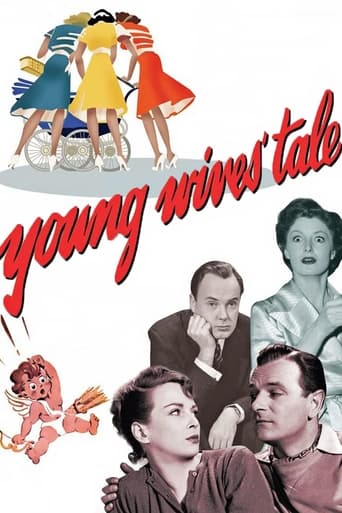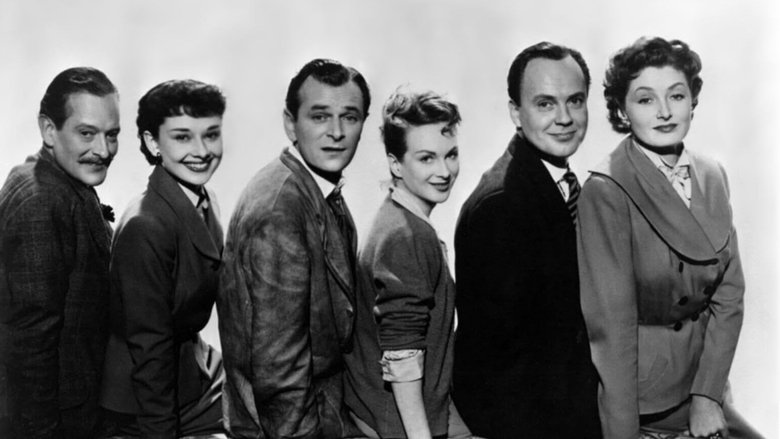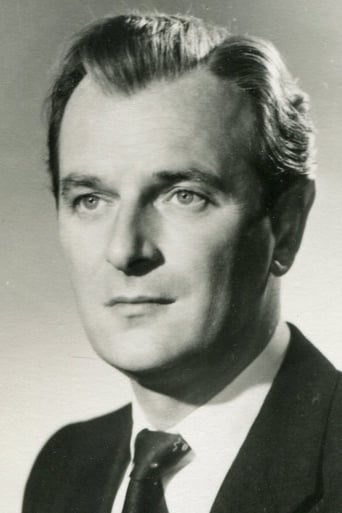

Young Wives' Tale (1951)
A post-war housing crisis leaves a shy woman to share a house with two couples. Comic situations arise as the new roomer becomes infatuated with one of the husbands.
Watch Trailer
Cast


Reviews
Undescribable Perfection
In truth, there is barely enough story here to make a film.
The film makes a home in your brain and the only cure is to see it again.
Strong acting helps the film overcome an uncertain premise and create characters that hold our attention absolutely.
This is a movie version of one of those brittle post-war stage farces, originally written by Ronald Jeans. Given then-current housing shortages, two couples -- Joan Greenwood & Nigel Patrick; Derek Farr & Helen Cherry -- are sharing a house. Each has one toddler, and only Miss Greenwood to work act dogsbody for the menage. Given her super-posh accent, she is an absolute flub at it, but she does get to show some athleticism as she leaps from one disaster to the next. When Miss Cherry locates a decent nanny for the children in the person of Athene Seyler, everyone thinks for a moment that the situation is saved, but for the purposes of the plot, they tell her the children are siblings, and she believes Miss Greenwood is married to Mr. Farr. The usual comedy of misconstruction ensues, carried on by speed by and the abilities of the cast. Alas, the effort never quite opens up beyond its stage origins.Movie fans will want to see this for a sizable supporting role by Audrey Hepburn. She plays a young woman who has a room in the house and whose salient quality is she is terrified of men. Although her character connects loosely with the plot at several points, I had the distinct impression that at some stage of the movie's origins -- perhaps before the play actually opened -- the role was actually much larger. Now it is largely vestigial, even if it is the main reason the movie is remembered.
Joan Greenwood (Sabina Pennant), Nigel Patrick (Rodney Pennant), Derek Farr (Bruce Banning), Guy Middleton (Victor Manifold), Athene Seyler (Nanny Gallop), Helen Cherry (Mary Banning), Audrey Hepburn (Eve Lester), Fabia Drake (Nurse Blott), Irene Handl, Joan Sanderson (nurses — Regents Park), Selma Vaz Dias (Ayah), Jack McNaughton (taxi driver), Brian Oulton (man in pub), Carol James (Elizabeth).Director: HENRY CASS. Screenplay: Anne Burnaby. Based on the 1949 stage play by Ronald Jeans. Photography: Erwin Hillier. Film editor: E. Jarvis. Music composed by Philip Green, played by the Associated British Studio Orchestra, conducted by Louis Levy. Art director: Terence Verity. Make-up: Bob Clark. Hair styles: A. G. Scott. Set continuity: Thelma Orr. Camera operator: Norman Warwick. Scenario editor: Frederic Gottfurt. Production manager: William A. Whittaker. Sound recording director: Harold V. King. RCA Sound System. Producer: Victor Skutezky.Copyright 15 August 1952 by Stratford Pictures Corp. New York opening at the Paris: 3 November 1952. U.S. release through Stratford: 9 June 1952. Made by Associated British Picture Corp., London. Released in the U.K. through Associated British-Pathe: 12 November 1951. Australian release through 20th Century-Fox: 23 April 1953 (sic). 7,108 feet. 79 minutes.SYNOPSIS: The housing shortage causes two families to share the one house.COMMENT: Little more than a photographed stage play. Only the slightest bit of opening-out is attempted. The core of the script is indifferent, with humor of the most basic and elementary slapstick and the usual stage caricatures. Nigel Patrick plays the bumbling, fall-over-anything-and-everything dad; Joan Greenwood the put-upon housewife who yearns to be glamorous; Guy Middleton once again cast as a ridiculously obvious would-be seducer; Helen Cherry is the toughie with a job; while Derek Farr essays the mild-mannered spouse; Athene Seyler does her bit as a doting nanny; while last but certainly not least in this second-rate company, Audrey Hepburn appears as a man-shy butterfly.Yes, I realize Audrey's presence is the main reason anyone would want to see this film, but be warned her role is small, though it does run through the whole play. In fact she has a couple of scenes and even a few close-ups. Although she acts in her usual prissy style (more so, if anything), she is neither flatteringly photographed nor costumed. Still fans will not have any trouble recognizing her. You can close your eyes even. That too-too upper- echelon voice and that arch dialogue delivery is an absolute trademark.Three or four very mild jokes enliven the single plot twist (the boofhead nanny gets the two couples confused) before an ineptly staged slapstick finale finally puts both audience and cast out of their misery.Cass's direction is surprisingly pedestrian. He's supposed to be a first-class and totally experienced Joe, but I wouldn't even engage him to direct traffic in a one-way street. Photography and other credits are also distinctly second class; and production values rate definitely way below economy class.
During a housing crisis in post-war Britain couples shared accommodations and often times problems arose. This 'comedy' was meant to parody situations of that nature, adding mild slapstick and rapid fire one-liners. It failed miserably back then and on viewing it recently, seemed like a pointless sketch of people wasting their time.While the British are responsible for some fine films, they also made some very bad ones (often referred to as 'B' movies). No wonder so many up and coming British actors migrated to Hollywood. Critics, at the time had no mercy on Director Henry Cass for this one.The sophisticated, lovely Joan Greenwood and Nigel Patrick are the young couple the Pennants, and Derek Farr and Helen Cherry, the Bannings, living together in a house with a single female roomer (Audrey Hepburn). Although IMDb's plot summary says the story centers around the young roomer's (Hepburn) infatuation with one of the husbands, it actually centers around one of the wives (Ms Greenwood, who gives a spirited, but sometimes annoying performance). From there comes a series of small situations that, for the most part are pretty lame and not very funny (at least by today's standards,and the critics back then, if you were to believe them, didn't find it funny either).It was better than some of television's new sitcoms however.It was reported by one of Ms Hepburn's biographers that Henry Cass was the only director in her entire career that 'she did not like working with'. Indeed, Cass was referred to as the 'tyrannical director', often finding actors to pick on for whatever reason. He chose Audrey as his whipping boy, and she only got through the making of this film under the protection of Ms Greenwood and Mr Patrick. Despite all the hell Cass was giving her, she still managed to show a hint of her screen appeal, and natural acting ability. She lit up the screen every time she appeared, and for that reason alone I gave the film a 6 star rating.Of course, you'd have to be a Hepburn fan to truly appreciate this film. It came out in 1951, but was re-released in 1954 to capitalize on Audrey's success with 'Roman Holiday'. I got my VHS copy from a film collector who was cleaning out his 'attic'. I would watch it again for the historic aspect of it. and because Miss Hepburn's speaking part is extended past those earlier walk-in roles she did.Overall, worth a watch if you can find a copy, and for me, this is a keeper.
I love this comedy and have watched it umpteen times. I haven't seen it for a while so the details of the plot escape me, but they don't really matter. What is so good about it is the unselfconscious depiction of London picking itself up after World War II, and the relaxed comedy style of the actors, most of whom will be familiar faces to anyone who watched British TV in the '70s too. Joan Greenwood is a dream as usual - watch out for the vault over the sofa - as a young housewife feeling ever so slightly bored with staying at home and the continuing hardships of the period - and where else could you see Athene Seyler, Fabia Drake and Irene Handl all together? Last and far from least there is a charming appearance from Audrey Hepburn in her fifth film. The men are good but this is really a treasury of female performances. It's all very light and stylish without being over-glamorous, very refreshing.Also, for serious buffs, the cinematographer was the great Erwin Hillier who worked with F.W. Murnau on 'Tabu', with Fritz Lang on 'M', and with Powell and Pressburger on 'A Canterbury Tale' and 'I Know Where I'm Going', and many other major movies.




